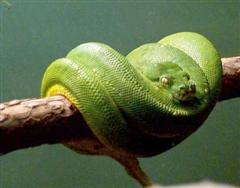Python - Green Tree
Chondro Scientific Name: Morelia viridis
Sat, 19th April, 2025 - 5:46 am GMT
Sponsor Ads:

Alternative Name
Chondro Scientific Name: Morelia viridisBasic Info
At maturity, the Green Tree Python reaches a size of four to six feet. Some specimens have been reported to be larger than six feet, but this is extremely rare. As the name implies, the Green Tree Python is mostly green. Most specimens have yellow, white, or blue stripes or spots on their back. The Green Tree Python has a narrow, laterally compressed body with a diamond shaped head that is much wider than its body. The head is covered with fragmented scales. The scales can be used to distinguish these snakes from the similar Emerald Tree Boa.
Health
The Green Tree Python can be difficult to care for. Some are finicky eaters and many specimens are very aggressive and quick to bite. They are not recommended for children or inexperienced snake keepers. The temperature of their cage should be about 80 degrees Fahrenheit. There should be a basking spot, preferably in the trees at 90 degrees Fahrenheit. Humidity should be high at roughly 80%, which can be accomplished by misting the habitat several times a day, or by using an automated misting system. The air in the habitat must circulate to avoid the growth of mold and fungus. Green Tree Pythons will get their water from the accumulation of water on the plant life, which comes from constant misting. A water bowl should be present, but this will hardly be used for drinking. It will serve more for soaking. Breeding Breeding the Green Tree Python in captivity can be very difficult. While there is little problem with mating, incubation and hatching conditions have proven difficult to ascertain. Often, the best approach is to leave the eggs with the female. When they hatch, the babies will be a yellow to brown color. Between six months and a year of age, the snake will gain its beautiful green coloring.Habitat
N/ABehavior
The Green Tree Python is a wonderful snake from the rainforests of Australia. It is a beautiful python with stunning coloration. In addition to this, its manageable size and relative ease of care make the Green Tree Python a highly prized pet for hobbyist. The Green Tree Python has a reputation for being nasty and aggressive. This is especially true of wild caught specimens. Green Tree Pythons that are born and raised in captivity are sometimes docile. Green Tree Pythons are not poisonous. Green Tree Pythons are very arboreal, and spend most of their time in the trees. All of their activities, eating, drinking, and breeding are accomplished from the trees. With this in mind, the Green Tree Python's habitat should be large, but should lean towards the tall side. It should contain plenty of plant life and branches for the snake to live in. When resting, the Green Tree Python will coil on a branch and rest its head between its coils.Origin
Indo-PacificHistory
The Green Tree Python, or Chondropython viridis can be found in the rainforest mountain areas of Papua New Guinea. It can also be found in the Cape York Peninsula of Australia.Common Foods
N/ASponsor Ads:
"Snow and adolescence are the only problems that disappear if you ignore them long enough."
Python - Green Tree
Coded by: BGID® | ALL RIGHTS RESERVED Copyright © 2000-2025
Disclaimer | Privacy | Report Errors / Contact | Credits
















